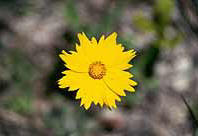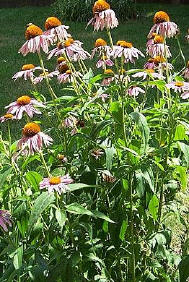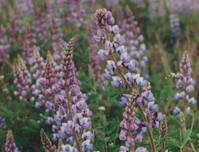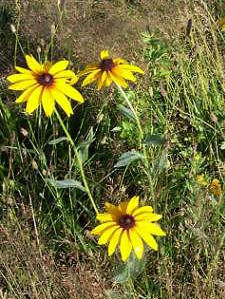Preparing a Sunny Wildflower Garden
Pam Wiehagen
Adams County Master Gardener
Wildflower blossoms have been appearing throughout Adams County in a striking display of color. Refreshing rays of bright, hot sunshine are beaming upon us and new wildflowers are opening every day. Now is the ideal time to begin planning a
sunny, low-maintenance wildflower garden that will reward you with blossoms from spring through fall next year.
The first step of this endeavor is to determine a suitable location which will receive six hours or more of sun a day and be situated where the view will be pleasing to you, your guests and neighbors, if desired. Garages, sheds and small
outbuildings provide backdrops that are especially picturesque when the flowers are blooming. Once a site is selected, the next step is to decide the garden size and shape. A garden hose or sand can be used to outline the garden.
|

Coreopsis lanceolata 
Purple Cone Flower
Echinacea purpurea
|
|

Lupine
Lupinus Perennis

Black-eyed Susan
Rudbeckia hirta |
Now it is time to deal with existing lawn or other vegetation growing in your future garden area. The lazy gardener's way is to cover the surface with black plastic (large, sturdy garbage bags are an excellent choice). Be sure to cover the
corners and seams with rocks or soil to prevent the plastic from taking flight in the wind. The hot August sun will beat down and bake the area killing the greenery underneath. Peek occasionally, if you must, but be sure to put the plastic back in place until October. By
then, all vegetation should be dead.
Remove the plastic and hoe the ground. Compost, horse or cow manure and peat moss are excellent sources of organic matter and their addition improves the drainage and soil structure. In most instances it is impossible to add too much
organic matter during soil preparation. But have a soil test made to determine the needed amendments and nutrients before you further prepare the soil.
Kits for this purpose are available at Adams County Extension Office for a nominal fee. Carefully follow the instructions and send your sample to Penn State. In a few weeks you will receive the results and recommendations for your garden
plot. Follow the guidelines for the addition of fertilizer, lime and organic matter. Shovels, hoes and tillers may be employed with equal effectiveness. Your newly prepared garden site will now lie dormant through late fall, winter and early spring. The ground may be left
bare or covered with plastic again.
Now is the time to start looking through seed catalogs for pictures of wildflowers suitable for our area. A mixture comprised of annuals and perennials should be selected. I recommend the following plant varieties for your consideration:
Calendula officianalis (Pot Marigold), Centaurea cyanus (Bachelor's Buttons/Cornflowers), Chrysanthemum Shasta Daisy, Coreopsis, Cosmos, Delphinium, Dianthus (Pinks/Carnations), Digitalis purpurea (Foxglove), Echinacea purpurea (Purple Coneflower), Eschscholzia californica
(California Poppy), Gypsophila (Baby's Breath), Lupinus (Lupine), Papaver rhoeas (Corn Poppy) and Rudbeckia hirta (Black-eyed Susan). If wildflower seeds are available locally, they may be purchased and stored in the refrigerator until spring. Otherwise, plan on purchasing
in early spring at local garden centers, variety or hardware stores.
Once the ground thaws and all danger of frost is past, remove plastic, rake the area, and sow with your choice of seeds. Cover the seeds with peat moss, water thoroughly and keep moist while seeds are germinating. Gradually allow the ground to become
drier as the plants grow but don't allow them to wilt. Soon you will be enjoying the anticipated display as first one flower unfolds and then the garden gradually explodes with long-lasting color.
On stressful days, take a break and head to your new garden. Sit under a nearby shady tree, sip lemonade and read a good book or The Good Book while quietly watching the activity in your wildflower bed. A butterfly, bee or dragonfly will
surely be landing before too long and you may be pleased to know that you are not the only creature enjoying the fruits of your labor.
Read other articles on ecological gardening & native plants
Read other articles on plants and gardens